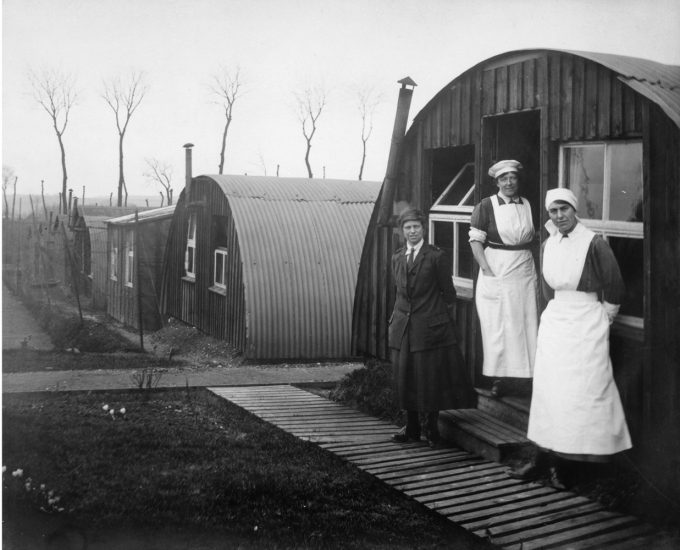
Commandant Johnson and two other women of the General Service Voluntary Aid Detachment (VAD) Motor Convoy outside Nissen Huts, Abbeville, France, 1919. Photograph by Olive Edis. (IWM Q8036)
No Man’s Land offers rarely-seen female perspectives on the First World War, featuring images taken by women who worked as nurses, ambulance drivers, and official photographers, as well as contemporary artists directly inspired by the conflict. Commemorating the First World War Centenary, No Man’s Land features photographs by three women of the epoch, alongside three women making work a century later.
Highlights include frontline images by nurses Mairi Chisholm and Florence Farmborough, some of which have never been exhibited or published; photographs by Olive Edis, the UK’s first female official war photographer despatched to a war zone; and new work by contemporary photographer and former soldier Alison Baskerville. This is the premiere of the nationally-touring exhibition before it travels to Bristol Cathedral, The Turnpike in Leigh, and Bishop Auckland Town Hall.
Unconventional motorcyclist-turned-ambulance driver Mairi Chisholm (1886–1981) set up a First Aid post on the Western Front with her friend Elsie Knocker. Using snapshot cameras, they recorded their intense life under fire at Pervyse in Belgium, just yards from the trenches. The images on display in the exhibition, drawn from Chisholm’s personal photo-albums, record her vitality and humour in the midst of great suffering.
Pioneering Olive Edis (1876–1955) is thought to be the UK’s first female official war photographer sent to a war zone, and one of the first anywhere in the world. A successful businesswoman, inventor, and high-profile portraitist, Edis photographed erveyone from Prime Ministers to Suffragettes. During the Armistice, she was commissioned by the Women’s Work Subcommittee of the Imperial War Museum to photograph the British Army’s auxiliary services in France and Flanders. Edis took her large studio camera on the road, often developing plates in makeshift darkrooms in hospital x-ray units. Her skilfully-composed images show the invaluable contributions of female engineers, telegraphists, commanders and surgeons.
On the Eastern Front, nurse and amateur photographer Florence Farmborough (1887–1978) documented her incredible experiences with the Russian Red Cross on the border of Galicia (present-day Ukraine and Poland). At a time when the British press avoided explicit images, Farmborough depicted the horrific consequences of war, including corpses lying in battlefields. Her images of Cossack soldiers, makeshift field tents, and Christmas in an old dug-out, offer rarely-seen views of the Eastern Front before Farmborough fled the Bolshevik Revolution in 1917.
Contemporary photographer Alison Baskerville is a former soldier with an insider’s perspective on women’s experiences in the armed forces. With Soldier, a new commission made specially for No Man’s Land, Baskerville has been directly inspired by Olive Edis to make a series of portraits of present-day women in the British Army. Working in collaboration with Ishan Siddiqui, Baskerville has produced a series of digital autochromes — a contemporary version of the early twentieth-century colour technology pioneered by Olive Edis. Presented as lightboxes, the portraits have a distinctive hazy appearance, made up of thousands of tiny coloured dots that glow.
Contemporary artist Dawn Cole was inspired by the chance find of a suitcase in the attic of a family house, discovering the photographs and diary of her great-aunt Clarice Spratling, a Voluntary Aid Detachment nurse in Northern France. Cole uses a many-layered technique incorporating photo-etching, digital manipulation and lace-making. She ‘weaves’ words from Clarice’s diary entries into images of lace-edged handkerchiefs and collars, creating photographic prints with hidden messages that explore the gulf between public face and private feelings.
Shot at Dawn by contemporary artist Chloe Dewe Mathews focuses on the ‘secret history’ of British, French and Belgian troops who were executed for cowardice and desertion between 1914 and 1918. Her large-scale colour photographs depict the sites at which the soldiers were shot or held in the period leading up to their execution. All are seasonally accurate and were taken as close as possible to the precise time of day at which the executions occurred. Made a hundred years later, her images show places forever altered by traumatic events.
No Man’s Land is a national touring exhibition curated by Dr. Pippa Oldfield and co-produced by Impressions Gallery, Bristol Cathedral, The Turnpike, and Bishop Auckland Town Hall.
